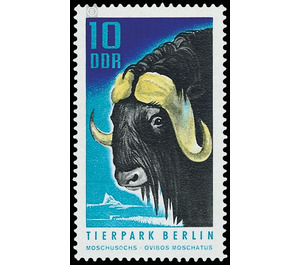Animal Park Berlin - Germany / German Democratic Republic 1970 - 10 Pfennig
Theme: Animals
| Country | Germany / German Democratic Republic |
| Issue Date | 1970 |
| Face Value | 10.00 |
| Color | black blue |
| Perforation | K 14 |
| Printing Type | Photogravure |
| Stamp Type | Postage stamp |
| Item Type | Stamp |
| Chronological Issue Number | 1359 |
| Chronological Chapter | GER-DDR |
| SID | 388217 |
| In 31 Wishlists | |
Berlin Zoo The Ministry of Posts and Telecommunications of the German Democratic Republic publishes four multicolored special postage stamps depicting various animals from the Berlin Zoo. Animals of Tierpark Berlin In the year 1970, Tierpark Berlin (founded August 27, 1954, opened July 2, 1955) is 15 years old. For this reason, the International Association of Directors Zoological Gardens holds its 25th Annual Meeting in Berlin-Friedrichsfelde. After twice stamp series of the GDR from Tierpark Berlin were inaugurated and helped to carry his name to all over the world, now again a set of four animals is to be issued, which brings particularly rare and attractive species to the representation. Each of the selected species has a special meaning for the zoo. It goes without saying that the choice of an animal stock of around 5000 forms was not easy. 10-pfennig value Moschusochs, Ovibos moschatus (Zimm.) For decades no musk oxen were to be seen in the zoos of the earth, because the international The zoo director association had decided in the 1920s not to buy musk oxen - only calves were eligible - because in each case a whole herd had to be shot down in order to reach them. These true ruminants systematically represent their own group and, according to recent views, are closer to the sheep and goats than to the cattle. That is why they were called sheep oxen. Muskoxen occur in three subspecies in northern Canada, Greenland and the Arctic archipelago. In order to multiply their stocks, they were also successfully exposed on Spitsbergen and in Norway, because they were at great risk in freedom, not least by an average increase in the annual temperature in their areas of occurrence, whereby their rutting behavior was disturbed, so that the number of Calves and of course their number decreased very much. The black-brown, dense, wool-haired fur - even the udder is hairy - protects it even against the greatest cold. During snowstorms, as well as in other dangers, the old musk-oxen of a pack - always six to eight animals under the guidance of a strong bull - stand around the calves, who protect them in their midst. Nobody bundles up with a bull so easily. Even in captivity, these can become true devils. During the polar nights, several flocks often unite to form a pack of 40 or more animals to cut lichens and mosses on snow-free spots. Otherwise they will eat creeping willow, saxifrage and mushrooms. After a gestation period of 8.5 months, one or two calves are set up in spring, looking like big poodles. Externally, they are among the nicest juveniles you know. Due to the aforementioned self-imposed restriction of zoo directors, there were only musk oxen in Leningrad and Copenhagen after 1925 in European zoos. In Denmark, it has also been bred successfully, but the calves have not been seen so far. It was not until the Alberta Game Farm in Canada held Alaskan musk oxen and were regularly bred that more were sent to zoos. The first zoo, which again received a pair on the European continent, was the Tierpark Berlin in 1967, which after laborious and successful familiarization in 1969 was also able to raise the first bull calf. Tierpark Berlin, with its integration into the stance of this rare ungulate, has once again rendered outstanding service to the endangered world of large animals, practicing nature conservation, which the musk-oxen owe so much to animal husbandry.


